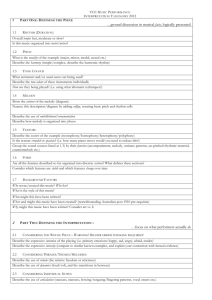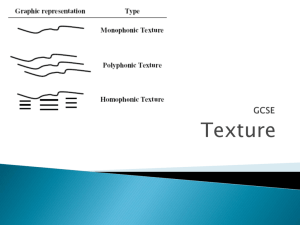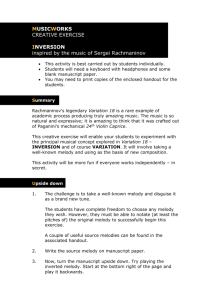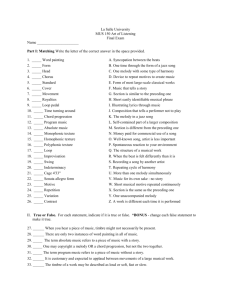Chapters 8,9,10
advertisement
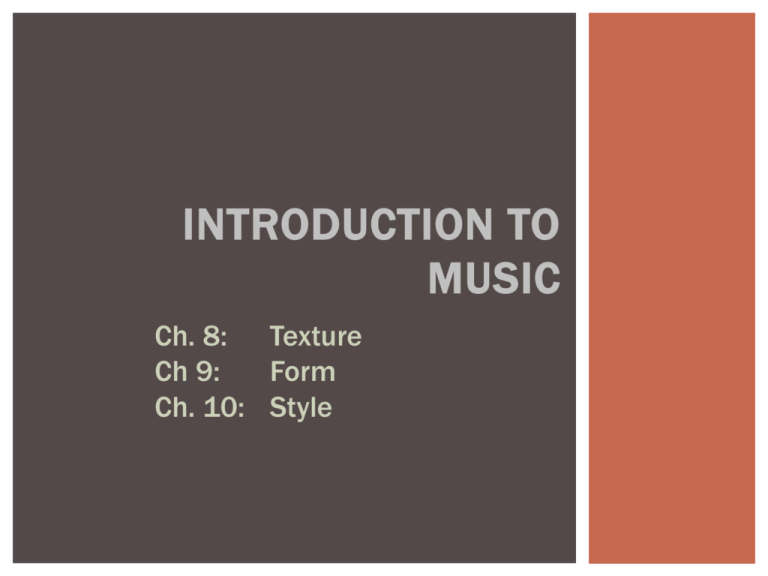
INTRODUCTION TO MUSIC Ch. 8: Texture Ch 9: Form Ch. 10: Style TEXTURE The musical “weave” or layers of what we hear together a melody several melodies a melody + accompaniment several melodies + accompaniment TEXTURE monophony = a melody vocal instrumental Men’s chest voices are naturally an octave _______ lower than the women’s head voices. Everyone in the room sings the same melody yes together. Is that monophony? ____ What term describes that phenomenon? unison _______ TEXTURE monophony = a melody polyphony (2 types) 2 or more melodies of equal importance sounding together imitation vocal instrumental 2 melodies A - ve Ma - ri ---- a A - ve Ma - ri ---- a A - ve Ma - ri ---- a A - ve Ma - ri ---- a TEXTURE vocal instrumental monophony = a melody polyphony = 2 or more melodies of equal importance sounding together Imitation 2 melodies homophony = melody in the foreground w/ subordinate accompaniment accompaniment accompaniment accom paniment accompaniment accompanime nt accompaniment accompaniment acco mpaniment accompaniment accompani ment accompaniment accompaniment a ccompaniment accompaniment accomp Melody unequal Texture MONOPHONY POLYPHONY SEVERAL DISSIMILAR MELODIES IMITATION HOMOPHONY SOOOO, WHAT DO YOU HEAR? IDENTIFY THE TEXTURE AND PERFORMING MEDIA: 1 2 3 4 5 6 7 8 9 10 FORM “…the organization of musical ideas in time.” (Kamien) Form builders: unity contrast variation repetition of musical ideas “musical glue” new musical ideas creates forward motion, suspense restated musical idea with some change(s) FORM Some example forms found in music: Time: 00:00 xx:yy piece 1: A B A piece 2: A A B B piece 3: A B A C piece 4: A (A A1 A’ A2 A” A3 A4 A”’ etc.) A B A A5 A6 How many sections in each piece? How many musical ideas in each piece? Does a piece’s form give any information about its length? Does each form balance new ideas and repeated ideas? What label from the previous slide would you apply to form #4? How does form #4 create and balance unity and contrast? LISTENING FOR FORM TCHAIKOVSKY, DANCE OF THE REED FLUTES A --B BIG CONTRAST A B Describe A: melody tone color range contour motion accompaniment Describe B: Compare with A melody similarities tone color dif ferences range contour motion accompaniment 3 sections 2 highly contrasting ideas A’ Kamien Pg. 50 LISTENING FOR FORM TCHAIKOVSKY, DANCE OF THE REED FLUTES A B A’ LISTENING FOR FORM TCHAIKOVSKY, DANCE OF THE REED FLUTES A --B BIG CONTRAST a--b some contrast A a b a’ Flute trio melody English Flute horn melody melody repeated B c Trumpet melody A’ a’ LISTENING FOR FORM TCHAIKOVSKY, DANCE OF THE REED FLUTES A a Flute trio melody b a English Flute horn melody melody repeated B c Trumpet melody A’ a LISTENING FOR FORM TCHAIKOVSKY, DANCE OF THE REED FLUTES A a a Flute trio a b b English horn a’ a’ a’ B c c c’ A’ a’ a’ a’ Trumpet melody Track the entire piece ST YLE …is what’s fashionable in terms of: melody rhythm tone color dynamics harmony texture form Listeners’ tastes determine the nature of each of these elements, and those tastes change throughout the course of history. For example, the 16th century was the “golden age of polyphony,” but homophony was favored in the early 17th century. 17th century music was based on long, complex melodies; 18th century listeners preferred simple, short, folk-like melodies. ST YLISTIC PERIODS 450-1450 1450-1600 1600-1750 1750-1820 1820-1900 1900-2000 5-15C 16C 17C 18C 19C 20C Middle Ages Renaissance Baroque Classical Romantic Twentieth Century ST YLISTIC PERIODS 5-15C 16C 17C 18C 19C 20C Middle Ages Renaissance Baroque Classical Romantic Twentieth Century WORK NEXT CLASS: Submit signed checklists. Kamien Part III: Ch 3, 4 BEFORE NEXT CLASS: 1 . Read the syllabus thoroughly & fill out Syllabus Checklist. 2. Register on Connect Kamien. 3. Part I: Work through Scan read Part III: Ch, 1 , 2, 4. In class: Part III, Ch. 3, 4 4. Review Elements Part I: Learn musical term definitions. Practice naming instruments by sound. YouTube Gems Connect Kamien 3 practice tasks 5. Explore: Text--learn structure & organization. Connect Kamien McGraw-Hill Online Leaning Center ML Hartman’s S.U. website TODAY’S PRESENTATION is posted at the Introduction to Music website: http://webspace.ship.edu/mlhartman/Introhome.html

